|
Archetypes
Dream symbols of the dark unconscious mind that all humans share.
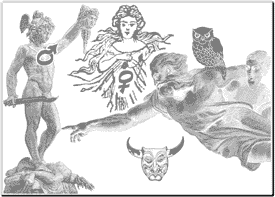
Greek: Archetupos; origin, pattern or model
ar·che·type [ahr-ki-tahyp] noun (Dictionary.com)
1. The original pattern or model from which all things of the same kind are copied or on which they are based; a model or first form; prototype.
2.In Jungian psychology: a collectively inherited unconscious idea, pattern of thought, image, etc., universally present in individual psyches.
•••
Simply defined it is a universal symbol for a pattern of behavior, or personality variable e.g. the generic version of a personality such as a Father Figure.
Carl Jung, the Swiss psychiatrist, made famous the idea of universal psychological images in dreams and myths that can be used to interpret dreams.
He suggested five main archetypes: The Self, Shadow, Anima, Animus and Persona.
•The Self regulates the psyche and facilitates the Individuation process (the process toward becoming a fully actualized human being).
•The Shadow is that part of us that we rather not acknowledge; it is our darker nature. It is often a dark creature, frequently of the same gender as the dreamer.
•The Anima is the feminine image and attributes within the male. It has been said that the soul of a man is feminine.
•The Animus is the masculine image and attributes within the female. It has been said that the soul of the woman is masculine.
•The Persona is our mask; what we present to the world as being our self.
There are many others, a few of which are described below:
• The Child: the divine child, the wonderful child that deals with the efforts of growing up.
• The Hero/Heroine used to be a demigod, with great courage and special birth and power whose quest is seen as a journey toward great service for humanity (e.g. Jason, Achilles, Perseus, Luke Skywalker, Harry Potter, the princess in the "Frog Prince," and for some scholars this list could include Buddha, Jesus and Mohammed). Many see this as a journey toward reconciliation; a connection between the spirit and body of man.
• The Great Mother (Queen, goddess, virgin Mary, Sophia, the Earth, Gaia, Lashmi) is often our own experience of mother and how we related to and influenced us toward independence.
• The Wise Old Woman (Queen, grandmother, goddess, your own mother), or Man (King, magician, prophet, wizard, father, guide, or authority figure)are full of power and wisdom and deep insight, and unconditional love.
• The Trickster (fox, jester, Brer Rabbit) sometimes can be seen as the wise fool, he whose antics can lead to transformation (often as a catalyst), but is also the least developed part of ones personality. It is a symbol of breaking the rules, but with ultimately positive effects for example in Greek myth Prometheus stole fire from the Gods to give to the humans, Jesus trashed the money lenders at the Temple, and Robin Hood stole from the rich to give to the poor. Native American Indians have a great tradition of using animals to represent the cunning features of the Trickster e.g. Coyote and Raven who are often seen as creators of the world. Raven can also be found in Norse and Siberian myths as well.
The White Rabbit in Lewis Carroll's book, Alice's Adventures in Wonderland, is a Trickster image who lures Alice to explore her unconscious and the naughty, or shadow, sides of her personality (see Down the Rabbit Hole)
•Death—meaning endings, our feelings about it and our myths about it and how our psyche deals with its inevitability. It clearly needs to happen at an ego-psychological level in order to be reborn i.e. transformed into something new. Each stage of our life needs to die to the next stage, if it does not we become fixated and don't move on. Seeing dead loved ones usually means that you are dealing with this death and trying to integrate the new relationship from the physical to that of the memory and all the emotions that go with that.
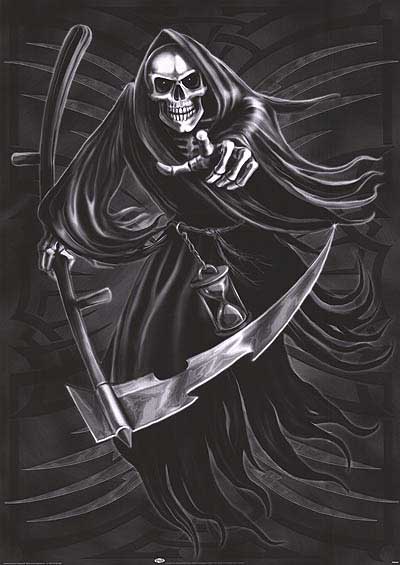 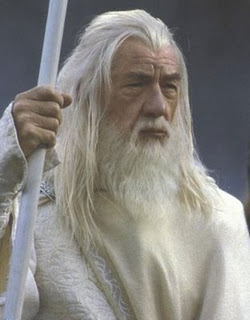
Death Archetype (could be the Shadow too) & Gandalf the Wise Old Man Archetype
As with anything in the imaginal world of the psychic archetypes, they are more metaphor than actual. We can't touch them, only point toward their attributes. They represent the patterns of the psychic function. The Depth Psychologist James Hillman said that they were the root of the soul. He goes on to say that because of this imaginal description of archetype we are lead "to envision the basic nature and structure of the soul in an imaginative way and to approach the basic questions of psychology first of all by means of the imagination." (Hillman, J., A Blue Fire, Harper Perennial, 1989, pg.23)
•••
More in-depth archetypical symbols can be found throughout the website. For example:
•http://thedreamingwizard.com/sophia_294.html (The Wise Old Woman)
• http://thedreamingwizard.com/the-individuation-process_274.html (The Shadow)
• http://thedreamingwizard.com/death-and-resurrection-in-dreams_295.html (death)
•••
In-depth study of the archetypes
Probably the most important archetype is the Persona, that part of each of us that is concerned about how we look to others. It is the part of us that interacts with others. It is the 'mask' that we wear in public—what we want others to see. States and countries, even religions have a Persona. Their symbols, whether they be flags or traditions, animals or anthems, legal codes, architecture, and stories of their history are all part of the mask to be presented to the world. But like with a mask, there is something behind it and when that is not acknowledged either publically and/or to itself, the shadow begins to take over.
male within the female: Shown as a man in a woman's dream, it would indicate assertiveness, mental and social power, latent characteristics, and even her contacts with males. This is called the Animus.
 These archetypes have their opposites as well in that whether Animus or Anima each has its positive nature and negative nature. The positive can reveal inner wisdom and spiritual and emotional depth, but the negative side might indicate that the negative aspects of the opposite gender are taking you over. For example the male in the female dream may be showing an arguementative, controlling or excessively critical aspect, thus the dream character could serve as a warning. The negative side of the Animus could be symbolized by a moody, irritable and oversensitive female character. Jung suggested that there was a proper balance to the inner gender qualities and that an unbalanced dream could serve as a means of guarding against this by not letting the negative dominate. These archetypes have their opposites as well in that whether Animus or Anima each has its positive nature and negative nature. The positive can reveal inner wisdom and spiritual and emotional depth, but the negative side might indicate that the negative aspects of the opposite gender are taking you over. For example the male in the female dream may be showing an arguementative, controlling or excessively critical aspect, thus the dream character could serve as a warning. The negative side of the Animus could be symbolized by a moody, irritable and oversensitive female character. Jung suggested that there was a proper balance to the inner gender qualities and that an unbalanced dream could serve as a means of guarding against this by not letting the negative dominate.
female within male:The female in a man's dream might represent the male's feminine aspects, such as caring and feeling, intuition, receptivity and creativity. This is known as the Anima. This character can show up in the form of an Elf, Goddess, mermaid or any female persona.
 It should be noted that Jung tended to create a splitting phenomenon when he asserted that archetypes such as the anima, animus and the shadow were only in a particular gender e.g. the animus in a female's dream only, anima in a male's and the shadow exclusively male within a male and female within a female. Dream analyst Jeremy Taylor doesn't believe that this is true. In fact he suggested that these designations of exclusivity were "arbitrary" (his word). Taylor considers the Jungian view to be somewhat masculinist and probably reflected unconscious gender stereotypes of the day. It should be noted that Jung tended to create a splitting phenomenon when he asserted that archetypes such as the anima, animus and the shadow were only in a particular gender e.g. the animus in a female's dream only, anima in a male's and the shadow exclusively male within a male and female within a female. Dream analyst Jeremy Taylor doesn't believe that this is true. In fact he suggested that these designations of exclusivity were "arbitrary" (his word). Taylor considers the Jungian view to be somewhat masculinist and probably reflected unconscious gender stereotypes of the day.
Taylor suggests that contemporary women have archetypal dreams of the feminine that correspond to the inner development of the Goddess and deserve to be called the anima. It is also the same for the animus. So what you might say? Because these Jungian designations are used as part of a diagnostic process and therefor are part of the therapeutic intervention, a rigid designation could cause great harm as well as skew legal determinations. Taylor suggests that some of the archetypal definitions be revisited in the light of contemporary sensibilities.
I tend to think that there's no good reason for this gender exclusivity given that there's male and female traits in all of us and to rule out the influence of a female shadow in a male who is trying to resolve his feminine aspect, or a female trying to do the same with her masculine seems a bit confusing, even the more so for those who are homosexual, lesbian, bisexual, or transsexual. There's also the interaction between males and females in the dream that can show both the positive and negative aspects of gender that can be informing.
Masculine Feminine traits:
Using standard gender characteristics (remember we each have both in us regardless of our gender) I perceive the Feminine to be:
Intuitive
Creative spontaneous
Receptive
Socially expressive
Contemplative
Inner world directed
I perceive the Masculine to exhibit the:
Assertive
Decisive
Physically expressive
Creative rational
Mental and Social power
Outer world directed
Of course there are the negative aspects:
The Feminine Receptive can become submissive and the Contemplative can become indecisive, Inner world directed can become insensitive to others, and the Creative spontaneous becomes unfocused.
The Masculine Assertive can become aggressive, physically expressive becomes violent, Mental and Social Power becomes arrogant and overpowering, Outerworld directed becomes aloof and insensitive and the Decisive can become inflexible.
ascetic or the monk: The loner. This person links us with things beyond the personal and unites us with all that seems separate. It can also mean a turning away or rejection of the everyday.
ascending: Up into the higher self with descending going down into the unconscious.
Father: Can represent not only one's own father but also God, the male leader, the progenitor of something. He is the original authority and one's strength in life. He can be represented by a wizard, an old man, a priest, a king, or wise old man.
Mother: Symbols can include the Virgin Mary, the sorceress, one's own mother, and the old woman. It can represent what influences our growth and development. Often both the father and the mother have great religious significance. For more on the Goddess see the page on Sophia.
Fool or trickster: Seen by some dream analysts as the least developed side of ourselves and that its physical appetites rule its actions and decisions. Its thinking is shallow and narrow and doesn't rise above its basal needs. The fool is self-centered, unfeeling, and cynical. But this is only one view of the fool archetype. Others see the fool as living in the here and now, he loves life, but is not attached to it and teaches us unattachment, simplicity and the joy of the moment. Both the young child and the old man share the qualities of the fool in that they are not run by how things look and are considered beings connected with the sacred. In the Native American culture, the fool archetype is frequently portrayed as Coyote who is often seen as a co-creator of the world. In its sacred role, the fool can be seen as the one who steps out of socially accepted patterns to point to a higher truth even at the risk of being denounced. By this definition, Jesus could be seen as the archetypal fool, trickster, or coyote.
 According to Jeremy Taylor, the Trickster is the archetype of consciousness and though it presents itself as weak and unassuming it is quite capable of creating much havoc and deception through very creative means and is frequently the bearer of new ideas. Trickster is both a creator and destroyer, but neither good or evil. He creates balance in the universe. He, or she, is also stubbornness personified in the face of prevailing reality. In short, it is the reflection of the human consciousness. According to Jeremy Taylor, the Trickster is the archetype of consciousness and though it presents itself as weak and unassuming it is quite capable of creating much havoc and deception through very creative means and is frequently the bearer of new ideas. Trickster is both a creator and destroyer, but neither good or evil. He creates balance in the universe. He, or she, is also stubbornness personified in the face of prevailing reality. In short, it is the reflection of the human consciousness.
Fugitive: Avoids and runs from things. He is the ultimate alien and loner. He represents fear, anxiety, and desertion.
Devil/Demon Can represent our struggle with our basic urges, that which pulls us down. The dragon can also represent this struggle.
Death: How we deal with our disintegration and demise. Symbols of death can be a stopped clock, a skeleton, gravestones, a cemetery, an empty abyss, falling leaves, or a dead animal.
This is probably the most difficult of archetypes to deal with as it involves the ultimate "letting  go." In a dream it can often shed light on one's relationship with it e.g. one's level of acceptance, or rejection of it. Often one's response to the death of someone else provides insight to their personal relationship with death. Denial of death in a dream can be a reflection of one's own denial. go." In a dream it can often shed light on one's relationship with it e.g. one's level of acceptance, or rejection of it. Often one's response to the death of someone else provides insight to their personal relationship with death. Denial of death in a dream can be a reflection of one's own denial.
In the American psyche death is often denied, hence our almost pathological resistance to it as evidenced in our dysfunctional health care system with our "life at all costs" mentality. Rejection of death can also reflect our level of fear associated with one's potential end. The ego (not as in 'egotist', but as in the persona that we think we are) cannot imagine its demise and the ultimate disintegration into oblivion. Our reactions to it in both the waking and sleeping dream state (I'm suggesting that before being fully awake to your inner self, you live your life as though in a dream, or semi-aware state.) can often reveal our ambient level of fear and the degree to which we unconsciously let fear determine the course of our life.
Much of life seems to be about letting go and confronting the emotional fallout that inevitably arises as part of the process of dealing with it. Most of the U.S. seems to have a rather immature relationship with death—with letting go—both personal, and by extension, the death of loved ones. To deny it is to never fully experience it as part of the process of living. None of this is to say that there is no grief when letting go. However, the only way to deal with grief, in my opinion, is to go with the extremely painful process of allowing it, not resisting it, or avoiding it, but to grieve when yo are grieving.
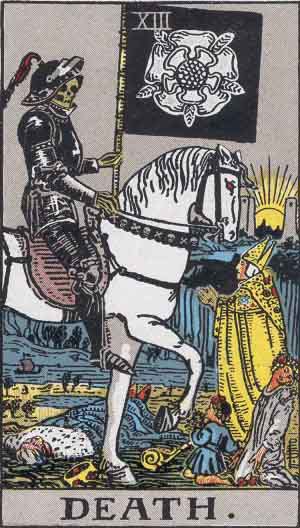 In addition, some death in dreams is more about the death, or end, to a circumstance (job, relationship, situation, etc.) versus your own personal death. The Death Tarot-signifying change, transition, an end and inevitability. The rose symbolizes life and new beginnings while the flag heralds a coming change. The sun reminds that where there is an ending, there is a new beginning. In addition, some death in dreams is more about the death, or end, to a circumstance (job, relationship, situation, etc.) versus your own personal death. The Death Tarot-signifying change, transition, an end and inevitability. The rose symbolizes life and new beginnings while the flag heralds a coming change. The sun reminds that where there is an ending, there is a new beginning.
(click here to enlarge)
See July 2nd and July 8th in the DreamDragon Blog for further meaning re: Death in dreams.
rebirth and resurrection: The unknown future and possibility often symbolized by an egg, spring, a rising sun, the cross, a budding flower, the phoenix, or the birth canal. This can be as difficult to confront as is death in that one needs to die to something before there can be a rebirth. The search for self is also the search for God—what we go through to grow up. To Jung, it was the process of individuation. The self as used by Jung meant the ego, that which we are aware of and that which we are not which he considered but a small part of who we are.
Symbols for birth and rebirth (resurrection, or eternality) are universal, for example the endless  knot shows up as long life in Chinese myth, all things joined in Tibet, and no beginning/no end in Celtic myth (timelessness). The same concept shows up in the Eastern Mandala, the circle (the endless cycle), the möbius strip (the 'one all'), Oruboros (Norse, Egyptian and alchemical symbol of the One, the integration of opposites, birth/rebirth and immortality), Yin/Yang (eternal stasis and balance; giving continuous rise to each other). Some physicists speak of oscillatory or eternal return universes to show that the universe may cycle through the same events infinitely. knot shows up as long life in Chinese myth, all things joined in Tibet, and no beginning/no end in Celtic myth (timelessness). The same concept shows up in the Eastern Mandala, the circle (the endless cycle), the möbius strip (the 'one all'), Oruboros (Norse, Egyptian and alchemical symbol of the One, the integration of opposites, birth/rebirth and immortality), Yin/Yang (eternal stasis and balance; giving continuous rise to each other). Some physicists speak of oscillatory or eternal return universes to show that the universe may cycle through the same events infinitely.
The concept of birth, death, rebirth shows up in the subatomic realm of Quantum Mechanics in Field Theory where the dualist quality of particles (e.g. an electron and its antiparticle, the positron) initially annhilate each other in a crazy burst of energy that creates a photon that creates another duality (electron-positron) that annhilates itself and creates another and so on.
See link pages: /index.php?page_id=295
Shadow: The dark side of the self, all the negative deeds or feelings that we have done, thought, and perhaps repressed or even actively suppressed. It hides our weaknesses and shortcomings. The shadow can be depicted as a shadowy figure of the same sex as the dreamer, the walking dead, the addict, the pervert, or anything threatening. To Jung, the shadow must be brought to the light and dealt with because the less it is acknowledged, the denser and darker it becomes.In early Christian, Jewish, and Islamic belief, dreams were thought to be either 'good', or 'bad' and that if bad, one should "take refuge from them." Bad dreams were considered to come from Satan and should, therefor not be entertained.
However, when one thinks that good and evil come from some place outside them, then the problem arises that if one never confronts and forgives the real source of their Shadow, it will come to rule them.
Note: in the Talmud good and evil dreams are acknowledged, though evil did have a plus side in that it could lead one to repentance.
 The effects of the unrecognized Shadow in our lives: The effects of the unrecognized Shadow in our lives:
In our waking life we can see the Shadow most easily by looking at all those people, or ideas, we most dislike or fear. The projection of the Shadow shows up collectively in the horrors of war, sexism, racism (any negative 'ism') and as the justifications for exploiting anyone and anything (read here as women or the environment). For most religions The Devil—Satan personifies the unrecognized internal Shadow and some form of Armegeddon becomes the metaphorical reconciliation between the opposites of the conscious self and the unconscious self (the shadow). But this battle is not to be won in the traditional sense in that the battle is about obtaining balance, not the destruction of one, or the other. But balance can't be obtained unless you know from where the imbalance comes from.
The oppression of women by males in any culture is an expression of Shadow Projection. Note: These Shadow Energies are inside ourselves and so long as we continue to not recognize them as coming from ourself we will continue to project them onto others. And to the extent that we think that the problem is outside us we will try to control and manipulate the world around us. But this vanity usually results in the feeling of less personal control and leads to even greater attempts to oppress or suppress others. All of this outer directed energy literally drains off our internal energy and we become ever more frantic, trapped and at the mercy of our circumstances.
Another of the characteristics of the Persona's projection of the shadow is the tendency to prematurely close off from all other possibilities other than the one's ascribed by you. You can see this collectively in those religions that purport to have the one and only Truth (this goes for the Science community as well), or in political organizations that suggest that only they have the answer, or nations that suggest they are the best. Polarization is a hallmark of the unrecognized Shadow.
Note: The shadow is also your opposite personality–it can be the extravert to your introvert, the thinker to your emotional side, the sensing aspect to your intuitive. It's the nondominant nondefault side to your personality.
While in the unrecognized shadow of the internal self the world’s problems seem to be outside ourselves so we try to manipulate this outside world with limited success. But this results in less not more personal control that then leads to even greater attempts to control others.
Those who reject their shadow either through the rejection of others or in their rejection of themselves shackle their opposite personality e.g. the extrovert to the introvert, the thinker to the emotional, the sensing to the intuitive. Note that in the evil person the shadow is its good side, its compassionate side.
For some this rejection hinders the expression of the “Oversoul”, the Christ, the symbol of the True Self, the Pneuma of humankind.
When we demonize another being we lay on them our shadow self in order to punish or kill them. For many the rejection of the shadow is equal to the rejection of sin. But the sin is not in having a shadow it is in refusing to recognize it and deal with it.
When we call another person arrogant who is it that is being arrogant? When we label another as being greedy whose greed is it we are rejecting or refusing to see? When we accuse someone as incompetent have we acknowledged our own contribution to that legion of dishonor?
Contrary to the common sense quote that what we don’t know won’t hurt us, the hidden parts of ourselves i.e. that which we don’t know, can hurt us, and others.
Taking a walk into the forest of our unconscious mind is not to be feared and run from for it is a journey toward healing and toward bringing balance to our chaotic lives.
_________________________________
*For an alternative definition see "Female within a Male" above.
Hero or heroine: You are the hero or heroine in your own life. You brave whatever the world gives you. It is what goes through each developmental phase of life, what dies to make way for what is new. It is a journey of epic proportions; it is your story. He or she points the way to the Self.
King:Is like the hero or the father, but he is the prime authority. He represents all aspects control, such as taking control or maintaining control. It is perhaps the most powerful aspect of fatherhood, the source and progenitor of us all.
Queen: Can often represent one's mother or someone or thing that acknowledges us.(see Sophia)
Lover:Represents all the forces that bind two people together, the intimacy, dreams, fears and pains, movement toward our wholeness, and all our personal experiences with love.
Martyr:Is the ultimate scapegoat; it may do what it does to be loved or appreciated. It can represent being abused or unrewarded.
Christ: May represent the symbol of the Self, soul, Oversoul, or the god-man.outcast: Is the archetypal feelings of abandonment and alienation of being different.
Christ is also the cosmic mystery that each of us has been born as—the essence of who we really are. To seek this is to undertake a powerful journey, not unlike that of Muhammad in the Night Journey.
 Muhammad and the Night Journey may very well have been a journey in quest of the Self, the spirit, to the Pneuma. This may be the archetypal journey in the search for the Self, our essence; our real self as opposed to the body or soul. This may relate to the process of Individuation as referred to by Carl Jung. Muhammad and the Night Journey may very well have been a journey in quest of the Self, the spirit, to the Pneuma. This may be the archetypal journey in the search for the Self, our essence; our real self as opposed to the body or soul. This may relate to the process of Individuation as referred to by Carl Jung.
Individuation: the process whereby a person reconciles the spirit with the ego by standing between them. In the book, The Gospel of Mary Magdalene translated by Jean-Yves Leloup, (as told by Mary Magdalene upon meeting Jesus and transcribed into the Gnostic Gospels):
"Lord, when someone meets you in a Moment of vision,
is it through the soul [psyche] that they see,
or is it through the Spirit [Pneuma]?"
"The Teacher answered:
'It is neither through the soul nor the Spirit, but the
nous between the two
which sees the vision..."
The nous between the two?; The self-actualized being?; The balance between Spirit and ego?
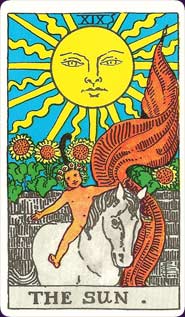
Child: Comes in many forms: The Divine Child: (see Christ above) Is Innocence and redemptive with god-like qualities. It often comes to you when you need to transform your traditional and conservative way of thinking and acting in order to transcend a situation or evolve your psycho-spiritual experience. It is always the creative vs. the conventional side of you wanting to be heard. But be careful here, conventional authority resists creative change, or change of any kind.
Rider-Waite Tarot Card. The child illuminates the mind (click here to enlarge)
Remember it was the conservative mind that saw threat in Jesus and ordered him to be killed. It was the conservative element that wanted the colonies to remain loyal to the British Empire, and it was the conservative mind that wanted to keep this nation a 'whites only' compound. But the spirit is always pressing to bring new light where there is darkness—to actualize spiritual possibility in our psyches. The Divine Child is always associated with new ideas and emotions coming into our awareness. The spirit is always pushing for increased awareness and consciousness. It comes to us in the form of the Divine Child, the child that can do amazing things even as a baby.
There are also the Nature Child: who attempts to bond us with the natural world; the Eternal Child: who encourages us to remain young and to see the world through the eyes of a child; The Magical Child: who sees the sacred beauty in everything and embodies the courage to face all difficulties; The Orphan Child: This may be the abandoned child who may not feel they belong anywhere and the Dependent Child: The needy child where nothing is ever good enough.
All have both a healthy and unhealthy aspect. All can come to you in a dream in the service of health and wisdom.
Wise old man or woman:Is full of holy power with their quality of wisdom being greater than that of the mother or the father. He or she can show up as the king, magician, a prophet, wizard, sage, doctor, sorceress, or shaman. There can be both negative and positive aspects to each. He or she can be the soul talking and is sometimes called the archetype of the spirit.
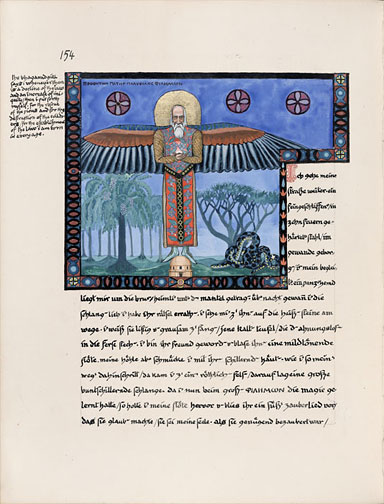
Click to enlarge
Liber Novus Ed. by Sonu Shamdasani, 2009, pg 154
The Goddess, the 'divine feminine', shows up as the Mother, the Queen, and the Wise old woman withese attributes of all. Goddess worship was cyclical and involved the phasing of the moon and crops and movement of wild animals. Our present day approach is linear in nature where everything changes and moves toward either greater knowledge or chaos. In the pagan world of the pre-Christian Celts the Goddess was a trinity— Maiden, Mother, and Crone— and represented symbolically as the phases of the moon. attributes of all. Goddess worship was cyclical and involved the phasing of the moon and crops and movement of wild animals. Our present day approach is linear in nature where everything changes and moves toward either greater knowledge or chaos. In the pagan world of the pre-Christian Celts the Goddess was a trinity— Maiden, Mother, and Crone— and represented symbolically as the phases of the moon.
The Maiden symbolizes youth, emerging sexuality, and the huntress running with her hounds. The Mother symbolizes feminine power, fertility, and nurturing. The Crone symbolizes wisdom, the compassion that comes from experience, and is the one who guides us through death.
Goddesses come by many names: Anahita, Anat, Aphrodite, Aradia, Arianrhod, Artemis, Astarte, Brighid, Ceres, Demeter, Diana, Eostre, Freya, Gaia, Hera, Ishtar, Isis, Juno, Kali, Lilith, Ma'at, Mary, Minerva, Ostare, Persephone, Sarasvati, Venus, and Vesta to name a few. (See Sophia page)

The Goddess symbol (Wiccan) Waxing (maiden), full (Mother), Waning (crone)
|